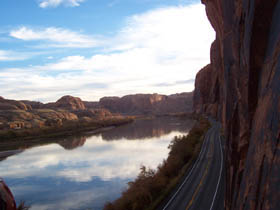
Pundits have long predicted the emergence of markets to reallocate water in the West. Water is a limited commodity, and the rapid growth of the West is only increasing competition for new supplies. Markets are the ideal tool to allocate scarce resources. So when water users in western Colorado confronted perhaps the biggest challenge to the future security of water use in Colorado—a curtailment of water under the multi-state Colorado River Compact of 1922—they envisioned water markets as a key component of the solution. In fact, they proposed a Compact Water Bank to respond to a potential curtailment.
But it is not so simple. Water markets have failed to gain widespread traction in the West. Even in Colorado, which has one the most active water markets, efforts to scale up and institutionalize water markets have struggled. In 2001, for example, when the state legislature authorized the Arkansas River Water Bank, hopes were high; but nine years later, there has not been one transaction through that bank.
A variety of factors confound the establishment of water markets in the West. Transaction costs to quantify and legally transfer water are significant. Many parties with direct (downstream water users whose water rights would be affected by a transfer) and indirect (boaters and fishers who recreate on local streams) interests in water can enter into transfer proceedings. The western heritage and culture in rural agricultural communities often resist transfers to growing cities. And perhaps most importantly, water in the western United States stubbornly defies commoditization due to the variability in hydrology, location, and priority of water rights. Progressive water users in Colorado are seeking ways to resolve these challenges and to employ markets to address the challenges of a new century.
Looking Back
There’s a long and rich history of the Colorado River. From a water manager’s perspective, one salient feature is that the vast majority of water originates as snowpack in the Upper Colorado River Basin, so the hydrography favors the Upper Basin States, which include Colorado, Utah, Wyoming, and New Mexico. But in the early 1900s, the lower basin states were growing quickly, and under the prior appropriation doctrine, there was concern that they could lay claim to the majority of the water in the Basin. Both sides had an incentive to negotiate, so in 1922, the seven Basin states signed the Colorado River Compact to allocate the waters of the Colorado River Basin.
At the time, measurements indicated an average of 15 million acre-feet (MAF) of water annually at Lee’s Ferry at the entrance to the Grand Canyon, the agreed upon measuring point. Essentially, they split that sum equally between the upper and lower basins. However, the Compact actually reads that the Upper Basin cannot cause deliveries to fall below 7.5 MAF on a 10-year rolling average. Thus the risk of low-flows resides with the Upper Basin.
As researchers developed a longer hydrologic record, it become apparent that 15 MAF was an overestimate of the amount of water in the Basin; current estimates place that number closer to 13.5 MAF. Couple this with concerns about climate change and models that show Lake Powell drying up, and the Upper Basin has been compelled to take a closer look at its ability to comply with the Compact.
This means the Upper Basin states may have to do more with less water, which is particularly pressing in Colorado due to the current allocation of water. We’ve all heard the maxim, “first in time, first in right.” In Colorado, it means that the senior water rights, those least vulnerable to a compact curtailment, are in agriculture, which was the first major use to appropriate water. Many of the water rights for cities and resort communities are junior and would be the first to be curtailed. In essence, Denver, Colorado Springs, Pueblo, and the rest of the growing Front Range could be left thirsty.
Inside a Water Bank
In the most basic sense, a water bank is an institution that uses free-market transactions to facilitate the temporary or permanent transfer of the rights to use water among water users. It does this by acting as an intermediary to bring together those holding legally valid water rights with those in need of additional water supplies. A water bank has a regular, transparent, institutionalized process for transferring water rights, which serves to reduce the confusion and costs associated with trading water. A typical bank also has a public sanction or purpose, for example, to alleviate the impacts of water shortage in a basin. In short, the goal of a water bank is to move water to where it is needed most.
There is no common template for a water bank; the participants, purposes, and rules of a bank can be tailored to meet the unique needs of a situation. In a review of western water banks, Clay Landry, a former PERC fellow and director of WestWater Research, found water banking activity in 9 of 12 western states, much of which commenced in the early 1990s to early 2000s. As applied to the Colorado River, this means that a water bank could be used to respond to a Compact curtailment. A Compact Water Bank would provide an institution for post-1922 water users (those vulnerable to a curtailment) to establish agreements with pre-1922 water users (those most secure against a curtailment). In the event of a Compact curtailment, these agreements would allow the post-1922 water use to continue by committing to the downstream delivery of the pre-1922 water use. The agreements would all be through willing seller–willing buyer transactions.
Interesting Bedfellows
The proposal for a Compact Water Bank has created some interesting bedfellows. I came to the project from an environmental perspective while working as the Water Program Manager for the Nature Conservancy in Colorado. We had a long working relationship with many of the water users in Colorado. While relations were collegial, we were often coming at issues from different perspectives; for example, on instream flows, water quality, and mitigation for the impacts of diversions.
Given my long-standing interest in using markets to reallocate water, I approached the water users when they first floated the concept of a Compact Water Bank and offered free labor to the water users. I proposed to examine the economic and institutional aspects of a water bank. While the water managers are experts in hydrology, delivery infrastructure, and water law, economics is often a forgotten discipline. They took me up on my offer. Each time I’ve spoken in public on this project, I’ve said, “I’m employed by the Nature Conservancy, but on this project, I report to the water users.”
The water managers were willing to explore new partnerships and new ways of thinking about water allocation in a future where water use in Colorado might be constrained by Compact limitations. For one, they agreed to let an environmentalist from Boulder, Colorado, help them develop their concept for a water bank. More importantly, water users from western Colorado reached out to the cities on the Front Range to hear their views on how a water bank could protect critical uses of water.
For those not from Colorado, this was an unlikely partnership to say the least. While demarking a physical drainage divide, the Continental Divide is also culturally significant in Colorado, at least with respect to the culture of water. The water users on the West Slope proudly call themselves a “counterirritant” to the cities that take water from western Colorado, and traditionally have done their best to thwart excessive diversions out of the Basin. Yet here they recognized the significant implications for the entire state and the need to engage prospective investors in a water bank.
Further, the water banking concept signals a new way of thinking about water in Colorado. The West Slope water users recognize the significant value they hold in their senior water rights. Not only can they do good by the state by participating in a water bank, but they can do well for themselves by extracting the highest monetary value for their water under a curtailment scenario. Yes, they still want to provide for the local economy and sustain the cultural heritage of agriculture in the West; but at the most basic level they are considering how to use market mechanisms to their advantage.
Next Steps
There’s a lot of work remaining. The proponents of a bank need a better understanding of the hydrology, water rights, and curtailment scenarios. They need to develop a more detailed model for how the bank would work to facilitate transactions. Most importantly, they need to continue to do outreach with water users on both sides of the Continental Divide to build a broad consensus for a Compact Water Bank.
Despite these hurdles, the trends in the West will demand new institutions and creative solutions to share water among competing users. If markets are intended to allocate scarce resources to the highest-value uses, this is a perfect opportunity to put one in place. Yes, it took a crisis. Yes, we’re a long way off. But a success here, at this scale, with these partners, and with so much at stake, could provide a model for water markets throughout the West.
Tom Iseman is the Program Director for Water Policy and Implementation at the Western Governors’ Association and is a PERC enviropreneur alum. He can be reached at tiseman@westgov.org.t



